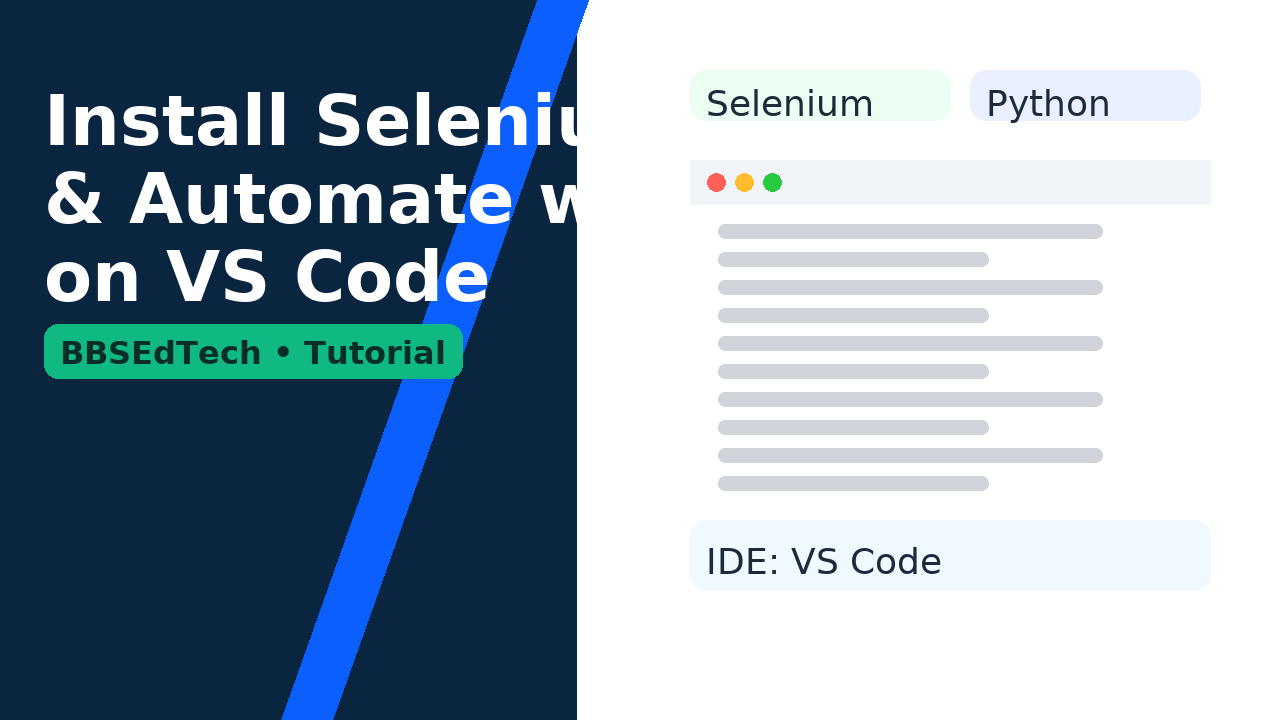Introduction
This tutorial gets you from zero to your first Selenium run using Python + VS Code. We’ll install packages, show the automatic driver method (easy) and the manual driver method (for locked-down environments).
Prerequisites
- Windows/Mac/Linux
- Python 3.8+ recommended
- Google Chrome (or Edge/Firefox/Safari)
Install Python
- Download from python.org.
- Windows: Tick “Add Python to PATH”.
python --version
pip --versionSetup VS Code
- Install VS Code and the “Python” extension.
- Create a folder and open it in VS Code.
- Open a terminal: View → Terminal.
Install Selenium
pip install selenium webdriver-managerOption A: Automatic Driver (Recommended)
webdriver-manager automatically downloads a compatible driver at runtime.from selenium import webdriver
from selenium.webdriver.chrome.service import Service
from selenium.webdriver.common.by import By
from selenium.webdriver.chrome.options import Options
from webdriver_manager.chrome import ChromeDriverManager
import time
options = Options()
options.add_argument("--start-maximized")
driver = webdriver.Chrome(service=Service(ChromeDriverManager().install()), options=options)
driver.get("https://www.google.com")
time.sleep(2)
box = driver.find_element(By.NAME, "q")
box.send_keys("BBSEdTech")
box.submit()
time.sleep(3)
driver.quit()Firefox/Edge with webdriver-manager
from selenium import webdriver
from selenium.webdriver.firefox.service import Service
from webdriver_manager.firefox import GeckoDriverManager
driver = webdriver.Firefox(service=Service(GeckoDriverManager().install()))
driver.get("https://www.example.com")
driver.quit()from selenium import webdriver
from selenium.webdriver.edge.service import Service
from webdriver_manager.microsoft import EdgeChromiumDriverManager
driver = webdriver.Edge(service=Service(EdgeChromiumDriverManager().install()))
driver.get("https://www.example.com")
driver.quit()Option B: Manual Browser Driver Setup
Download the matching driver (ChromeDriver/GeckoDriver/EdgeDriver) and point Selenium to its path.
from selenium import webdriver
from selenium.webdriver.chrome.service import Service
from selenium.webdriver.common.by import By
from selenium.webdriver.chrome.options import Options
import time
options = Options()
options.add_argument("--start-maximized")
chromedriver_path = r"C:\tools\drivers\chromedriver.exe" # Update this
driver = webdriver.Chrome(service=Service(chromedriver_path), options=options)
driver.get("https://www.google.com")
time.sleep(2)
driver.find_element(By.NAME, "q").send_keys("BBSEdTech")
driver.find_element(By.NAME, "q").submit()
time.sleep(3)
driver.quit()Manual: Firefox & Edge examples
from selenium import webdriver
from selenium.webdriver.firefox.service import Service
gecko_path = r"C:\tools\drivers\geckodriver.exe" # Update path
driver = webdriver.Firefox(service=Service(gecko_path))
driver.get("https://www.example.com")
driver.quit()from selenium import webdriver
from selenium.webdriver.edge.service import Service
msedge_path = r"C:\tools\drivers\msedgedriver.exe" # Update path
driver = webdriver.Edge(service=Service(msedge_path))
driver.get("https://www.example.com")
driver.quit()Your First Script
Run either the automatic or manual sample above. For CI or containers, prefer manual with pinned versions.
FAQ & Fixes
ModuleNotFoundError: selenium
Install into the active interpreter: pip install selenium. Use the VS Code interpreter switcher on the status bar.
NoSuchDriverException
Let webdriver-manager handle versioning or ensure ChromeDriver matches your Chrome major version.
Run headless
options.add_argument("--headless=new") before creating the driver.
Safari on macOS
Enable “Develop → Allow Remote Automation” and use webdriver.Safari(); no external binary needed.
